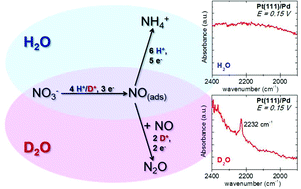Mechanistic changes observed in heavy water for nitrate reduction reaction on palladium-modified Pt(hkl) electrodes
Abstract

* Corresponding authors
a
Instituto de Electroquímica, Universidad de Alicante, Apartado 99, Alicante, Spain
E-mail:
juan.feliu@ua.es
b
Universidade Federal do ABC, Centro de Ciências Naturais e Humanas, Rua Santa Adélia, 166, Bairro Bangu, Santo André, SP, Brazil
E-mail:
janaina.garcia@ufabc.edu.br
c Instituto de Química de São Carlos, Universidade de São Paulo Av. Trab. São-carlense, 400, CP 780, São Carlos, SP, Brazil

 Please wait while we load your content...
Something went wrong. Try again?
Please wait while we load your content...
Something went wrong. Try again?
J. Souza-Garcia, E. A. Ticianelli, V. Climent and J. M. Feliu, Chem. Sci., 2012, 3, 3063 DOI: 10.1039/C2SC20490H
To request permission to reproduce material from this article, please go to the Copyright Clearance Center request page.
If you are an author contributing to an RSC publication, you do not need to request permission provided correct acknowledgement is given.
If you are the author of this article, you do not need to request permission to reproduce figures and diagrams provided correct acknowledgement is given. If you want to reproduce the whole article in a third-party publication (excluding your thesis/dissertation for which permission is not required) please go to the Copyright Clearance Center request page.
Read more about how to correctly acknowledge RSC content.
 Fetching data from CrossRef.
Fetching data from CrossRef.
This may take some time to load.
Loading related content
